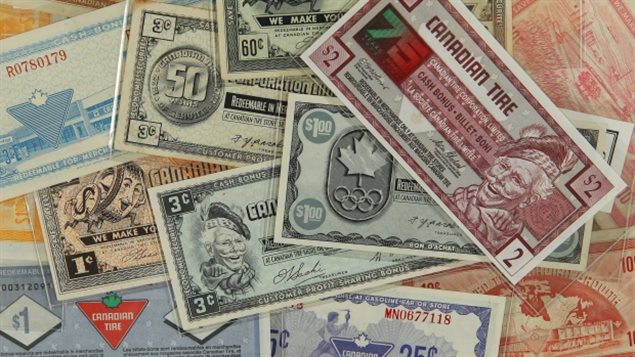It’s an iconic symbol of Canada: Canadian Tire and its “money” which features the smiling face of the the thrifty Scot, Sandy McTire.
In the vast majority of cars in Canada you will find Canadian Tire money, perhaps in the glove box, ashtray, under the seats, in the trunk, and of course stockpiled in homes. .
After several decades of handing out redeemable “bills” in denominations from a few cents, to two dollars, one can ask–is the tradition being quietly phased out?

But let’s back up a bit.
Canadian Tire began in 1922, when the Billes brother, JW and AJ, bought an automobile repair and tire sales shop in Toronto, Ontario. The next year they sold that store and moved into a larger operation under the new name Canadian Tire Corp oration (CTC). An affiliate operation was opened a few years later in the city of Hamilton in 1934. That was the start of what would eventually become a huge chain with almost 500 “affiliate” stores from coast to coast.
According the Canadian Tire website, more than 90% of the population of Canada lives within 15 minutes of a Canadian Tire store (presumably 15 min by car?)

Originally selling tires and auto supplies, the stores began branching out and now include clothing, sporting goods, camping, gardening, and cooking equipment, electrical and plumbing supplies, furniture and more, along with a vehicle repair garage.
In 1958, the stores introduced a loyalty programme with the now famous Canadian Tire money, given to cash paying customers. At first redeemable only at their gas bars, it was extended to the stores in 1961.
The bills, although somewhat smaller than actual Canadian banknotes, were printed on quality paper by the same company that printed banknotes.
One of the most succesful loyalty programmes created CTC money was originally given out as five percent of the value of a sale. Over the years the percentage has been reduced to 0.5 percent per dollar spent, but can still be redeemed on any purchase in the store.
Unusual purchases
To indicate the potential of CTC money, in 2011 an Edmonton man cashed in all the CTC mony he collected for 15 years, over $1,000 worth and drove away with a riding lawn mower.
In Toronto, a musician paid a recording studio which accepts the bills, and with his stockpile of over $6,000 worth of notes, managed to get his album recorded

Digital age catches up
In 2014, in an interview on IT Business, http://www.itbusiness.ca/video/phygital-retailing-with-canadian-tires-rex-lee
the vice president said that although they have introduced a new digital version of the loyalty programme the paper bills would still be around.
The tags can electronically track purchases to help in reducing the costs in handling the money. They can also track what people are buying to potentially target advertising to individuals, and also of course to track what items or genre of items are selling.
However at a store this week, a sales clerk told me they were not handing out the paper money anymore and gave me a digital tag instead.
So although there has been no official announcement, and in spite of the 2014 assurance, one wonders whether a slow quiet phase-out of the bills has begun
After almost six decades of collecting and redeeming the pictures of good old smiling Sandy, will the bills become a quaint reminder of a period in Canadian history, or even collectors items some day? Only Sandy seems to know, and as a cunning Scot, he’s not telling.







For reasons beyond our control, and for an undetermined period of time, our comment section is now closed. However, our social networks remain open to your contributions.